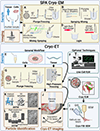Recent advances and current trends in cryo-electron microscopy
- PMID: 36323134
- PMCID: PMC10266358
- DOI: 10.1016/j.sbi.2022.102484
Recent advances and current trends in cryo-electron microscopy
Abstract
All steps of cryogenic electron-microscopy (cryo-EM) workflows have rapidly evolved over the last decade. Advances in both single-particle analysis (SPA) cryo-EM and cryo-electron tomography (cryo-ET) have facilitated the determination of high-resolution biomolecular structures that are not tractable with other methods. However, challenges remain. For SPA, these include improved resolution in an additional dimension: time. For cryo-ET, these include accessing difficult-to-image areas of a cell and finding rare molecules. Finally, there is a need for automated and faster workflows, as many projects are limited by throughput. Here, we review current developments in SPA cryo-EM and cryo-ET that push these boundaries. Collectively, these advances are poised to propel our spatial and temporal understanding of macromolecular processes.
Copyright © 2022 The Author(s). Published by Elsevier Ltd.. All rights reserved.
Conflict of interest statement
Conflict of interest statement Nothing declared.
Figures


